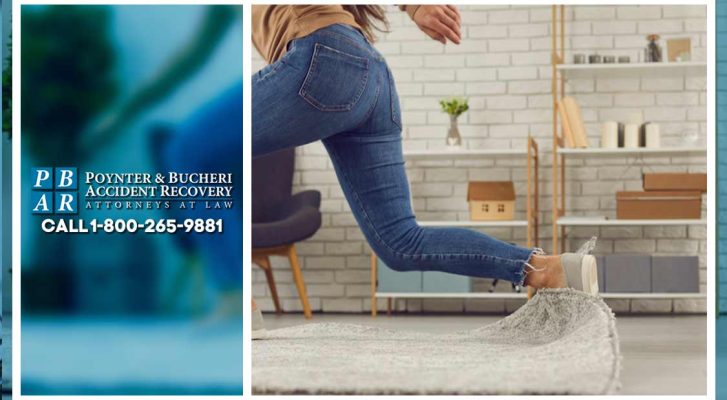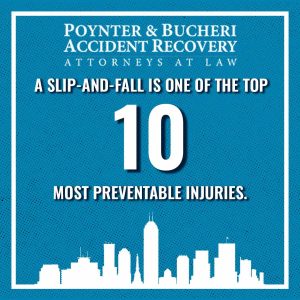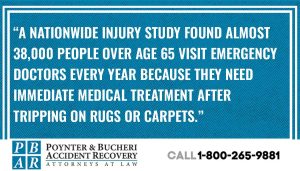
How to Prevent Slip and Fall Accidents


A slip-and-fall is one of the top 10 most preventable injuries. Falls are also among the nation’s top 3 causes of potentially preventable deaths, along with poisonings and traffic accidents. Although preventing all slip and fall injuries is impossible, you can take steps to protect yourself. Here are some helpful tips on how to prevent slip and fall accidents from Poynter & Bucheri Accident Recovery.
How to Avoid Slip and Fall Accidents
Dangerous rugs and carpets cause many slip-and-fall accidents. A nationwide injury study found almost 38,000 people over age 65 visit emergency doctors every year because they need immediate medical treatment after tripping on rugs or carpets.

Property owners should inspect flooring regularly and replace anything worn or broken. Ensure walking surfaces are free from loose flaps or uneven areas where someone could trip.
Another top contributor to slip-and-fall accidents is bad weather. When rain, ice, snow, and slush are present, they create dangerous areas where it’s risky to walk. Watch out for these dangers and address weather-related risks quickly if you’re a property owner. Don’t allow snow and ice to persist.
You can’t stop the aging process, but age is unfortunately a contributor to fall risk. Among older adults, falling is the #1 cause of traumatic brain injuries and hip injuries. One out of every five falls will result in a severe injury like a head injury or broken bone.
Beware of age-related and mobility-related challenges your property’s visitors may have. For example, if you have a physical therapy practice, consider how a crumbling parking lot surface poses a danger to your patients.
Lighting is another factor. When an area is poorly lit, the risk of a slipping or tripping injury rises. The Centers for Disease Control warns that in retail stores, ladders and lighting are two top causes of injuries like slips, trips, sprains, strains, scratches, and fractures.
Property owners should establish inspection and cleaning protocols. Assign someone to look over all areas regularly for hazards. Address problem areas immediately to prevent people from suffering injuries on your property.
Cover or secure objects that might dangle into walkways, like cords and cables. This is especially important in heavily trafficked public areas and construction zones where debris might cause people to veer into unsafe paths.
A Summary of How to Prevent Slip and Fall Accidents:
- Avoid areas with ice, oil, potholes, and other hazards.
- Take extra care during bad weather when there are slick surfaces.
- Watch out for loose, worn, and crumbling flooring materials.
- Consider the impacts of aging, mobility, and visibility.
- For property owners, clean up spills and clutter to leave walkways clear.
- Secure and cover loose objects like cords and cables.
- Look for opportunities to add light and safety features.
- In dangerous areas, post warning signs.
- Never allow hazards to persist.
Who is Liable in a Slip and Fall Accident?
After a slip and fall accident, the injured person can seek compensation from a property owner who knew about the hazard and allowed an unsafe environment. Indiana property owners can’t permit dangerous conditions to continue or they may be held liable for an injured person’s medical bills, lost wages, and other damages.
The liable party in your case may be:
- A property owner
- A landlord or rental/leasing company
- A building or land maintenance company
- An employer
- A retail company
- A government agency
In Indianapolis, property owners are responsible for the general safety of visitors, including maintenance duties like clearing hazardous ice and snow within a reasonable time after it falls. They may receive a warning, a $50 fine, or other penalties for failing to do so.
Judges and juries have to make judgment calls about whether property owners acted reasonably in addressing slip-and-fall dangers. Insurance companies may cover the costs of slip-and-fall injuries, but only if there is clear evidence that the covered property owner is liable.
As a property owner, the onus is on you to maintain your property and hold proper insurance coverage. If you’re injured on someone’s property, it’s up to you to pursue compensation for your injuries and losses.
What to Do in a Slip and Fall Accident
After a slip-and-fall accident, seek emergency help immediately. See a doctor for any injury, even a mild one, and help establish your timeline and medical records related to your accident.
Beware of signs of a hip injury or leg injury, like trouble walking or coordinating your movements. A doctor can determine whether you need surgery after a slip-and-fall, like back, neck, or hip surgery. You may need treatment for a concussion or traumatic brain injury (TBI). The costs of these medical procedures add up quickly, so save your paperwork and start thinking about making a slip-and-fall accident claim.
Don’t miss your opportunity to take photos and videos at the scene of your injury, if you’re able to. Write down any relevant details, like the weather, nearby signs, debris on the floor, lighting conditions, and anything else that contributed to your fall. Gather contact information from any witnesses who saw what happened.
Notify the property owner as soon as possible after the accident and request an incident report. Avoid getting into an extended conversation or argument and explain that you’ll be seeking legal input as your next step.
Slip and Fall Injury? Contact Poynter & Bucheri Accident Recovery
You deserve fair compensation for your slip-and-fall injury. We can help you understand how to prevent slip-and-fall accidents, who may be liable for your injuries, and how to evaluate your legal options. To learn more and request a free slip-and-fall case review, contact Poynter & Bucheri Accident Recovery at 1-800-265-9881.
